After You Capture A Lead, What Comes Next?
- Fahad H

- Mar 27, 2013
- 6 min read
Congrats on generating some awesome leads for your sales team! Now what? As marketers, our primary responsibility is to generate qualified leads for sales. However, our job doesn’t stop immediately after we get the leads in the door.
Answering the “Now what?” question can be tricky. Just because someone downloaded your ebook or subscribed to your blog doesn’t mean they are ready for your sales team — in fact, Gleanster Research (pdf download) found that 50% of leads are qualified, but not ready to buy just yet. Effective lead nurturing campaigns can help you move your leads through the buying cycle, thus preparing them for the sales team. Below, we will cover:
What Emails to Send At Each Stage of Your Next Lead Nurturing Campaign
How to Nurture Leads at Each Stage of the Buying Cycle Effectively
Real-world Examples of Lead Nurturing Emails to Accelerate Your Sales Cycle
What Is Lead Nurturing?
Before we jump into what types of emails you should be sending and when, let’s do a quick primer on what lead nurturing is. Lead nurturing is a series of emails that you send to your leads in order to qualify them and move them down the sales funnel. Sometimes, you might hear lead nurturing referred to as a marketing automation campaign.
Unlike one-off email blasts, lead nurturing focuses on sending prospects the right content at the right time based on characteristics such as buyer personas and what stage they are at in the sales cycle.
Providing leads with the right content based on their stage in the buying cycle is essential for a successful lead nurturing campaign. After all, the content that resonates best with a new blog subscriber isn’t the same as what speaks to a lead close to a sale. Luckily, we’ve made it easy for you. Here are the types of emails you should be sending at each stage of your next lead nurturing campaign.
Educate & Inform To Convert Subscribers To Leads
Within your marketing database, you likely have prospects at all stages of your sales funnel. At the very top of the funnel, you have subscribers. These are people who have opted in to hear from you periodically. You likely have limited contact information for them, perhaps just an email address. A subscriber may have entered your database by subscribing to your blog or opting in to a company newsletter.
At this stage, the goal is to convert these subscribers to leads by getting them to convert on a landing page. While it’s great that you have a database of people who have voluntarily signed up to hear from you, subscribers have not invested heavily in your company yet, and it’s very easy for them to opt out.
Show subscribers you’re worth sticking around for by providing them with quality, educational content. Your focus on education will build trust between the subscriber and your company that will make them more willing to share information with you. Here are two emails to send in this stage:
1. Educational Content
Let’s face it, with just an email address, you really have no idea what particular issues a subscriber wants to learn more about. However, I bet as a marketer, you can think of a few common challenges that are keeping your customers up at night.
Send educational content that focuses on a broad issue the majority of your audience faces with the option to dive into a specific subject with blog links or offers. By tracking what links or offers subscribers are clicking on, you can then segment your subscriber list to further refine your content offers. For example, the email below includes data relevant to marketers along with an ebook offer to entice subscribers to convert to a lead
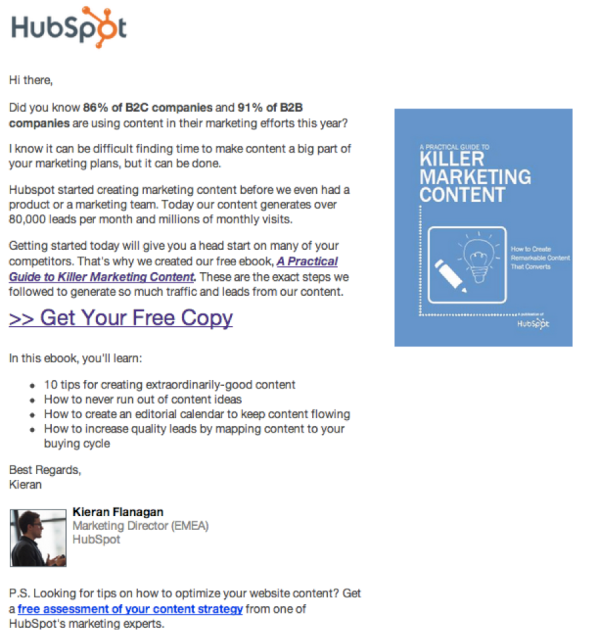
Go the extra mile here by using progressive profiling to make filling out forms easy as pie.
2. Industry News and Trends
One of the reasons people subscribe to industry blogs or newsletters is to stay abreast of the latest news. Help your subscribers have their finger on the pulse by sending out updates on industry news and trends. This will help engage your audience, and build yourself as a trustworthy knowledge source. When Pinterest announced its new analytics feature, we made sure to share the news with our subscribers with this email.
To strengthen this authority and encourage subscribers to become leads, create content that suggests how to strategize in light of changes. In this case, we revamped a Pinterest ebook to reflect the new changes. This strategy puts your company in the role of both informer and advisor.
Become A Problem Solver To Convert Leads To Marketing Qualified Leads (MQLs)
Leads are prospects in your database that have given more information about themselves than just an email address. Most people become leads after converting on a landing page, usually in exchange for a content-based offer. The goal for marketers in this stage is to get the lead to further qualify themselves for sales by acting on a specific call-to-action. Here are the types of emails you should be sending your leads.
1. Targeted Educational Content
Unlike the generalized educational email you would send a subscriber, now’s your opportunity to send targeted emails to your lead based on the information you know about them. This segmentation can either be by your company’s buyer persona or by the content they previously converted on.
For example, if someone filled out a landing page to register for a lead nurturing webinar we’re hosting, I would send an email like this, offering more content on the subject that the lead expressed interest in.
To make this offer extra juicy, don’t forget to tell your leads what to do next to learn more. Include call-to-action buttons and links to other relevant content within the offer to increase engagement and conversion rates.
2. Problem Solvers
Want to know the best way to convince me to invest in your company’s product or service? Show me you can solve my problem. If you can solve a lead’s pain points before they even become a customer, imagine how much more likely she is to listen to your sales pitch.
Not only will leads view your company as a solutions provider, but the leads who click through on this email are more likely to be qualified for your sales team. Problem-solvers can include HTML tools, a checklist, or an infographic of a process they have to do frequently — anything that you imagine they would print out and hang by their desks.
To help our marketing leads, we created a blogging calendar that assists them in doing their job better. Here’s an email we sent them:
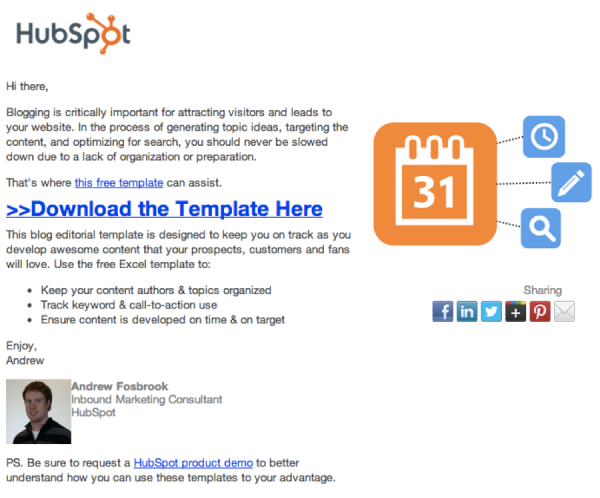
Set up your sales team for success by having the email come from the prospect’s sales rep’s email address rather than a generic marketing alias. This builds trust on an individual level and can open the door to future conversation. Also, if the prospect responds to the email, it will go right to the sales rep’s inbox.
3. Social Proof
Motivate your leads to pursue becoming a customer with social proof. Social proof is the idea that if other people are doing something, and I trust those other people, then I should be doing it to.
Show leads that there are plenty of people just like them that trust your company by inviting them to become a part of the conversation. Invite them to social media chats (like tweetups), webinars, or other interactive community-based offers. Here’s an invitation we sent to leads in the ecommerce space for an upcoming webinar:
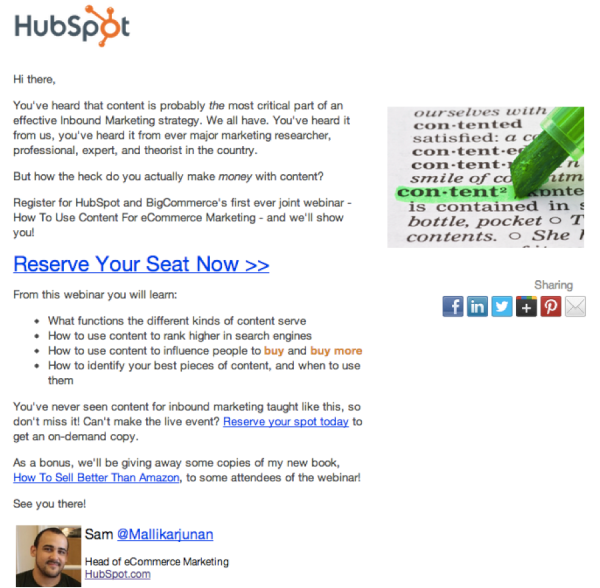
To further emphasize your company’s role in the ecosystem, feature co-marketing offers you create with other companies in the space. For example, this webinar was paired with BigCommerce.
4. Product Introduction: Features and Benefits
In addition to providing your leads with quality information and content, make sure to introduce them to your product or service. Since you now have more information about their background and content interests, introduce them to your product features and benefits in a way that will resonate with them.
For example, leads who downloaded our “101 Companies Rocking Social Media” ebook received the email below with a demo that specifically emphasizes our social media tools.
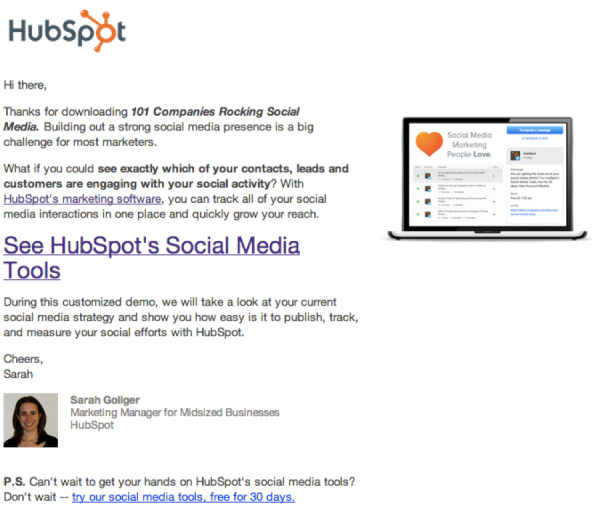
The most successful product-centric lead nurturing emails make it about the recipient, not the sender. Position your product messaging in a way that emphasizes the lead’s stated priorities and encourages them to a sales-specific call to action.
Support The Decision-Making Process To Convert MQLs to Sales
Marketing Qualified Leads, or MQLs, are people who have identified themselves as deeply-engaged, sales-ready leads. Leads usually become MQLs by following product-centric calls to action, such as requesting a trial, product demo or request to contact sales.
The goal for marketers here is to assist the sales team and make the MQL’s decision-making process as easy as possible. Here are the emails marketers should send at this stage of the game.
1. Proof of Product
Help an MQL see that your product or service gets results by sending proof of product. This type of email can be anything from results-oriented data, case studies, or testimonials. Give the MQL results he could use to make the case to his boss or teammates about your product or service.
This case study email includes both a quote from a satisfied customer and numbers to support exactly how he found success with our product.
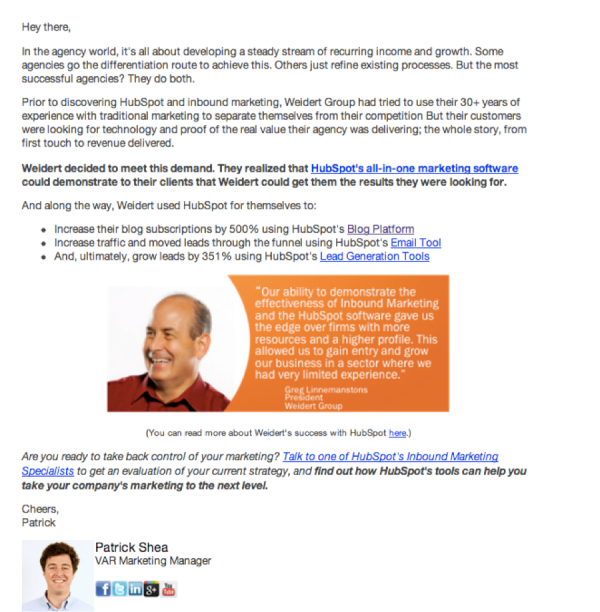
Take this step the extra mile by giving the MQL the option to talk to a current customer who loves the results they’re getting from your service.
Other ways to assist sales in this stage of the lead nurturing process are to write updates on product features, create customer-facing content that analyzes your offerings vs. competitors, and continue to send targeted, educational content.
What are some of your go-to emails to send to subscribers and leads? Let us know in the comments!








Comments